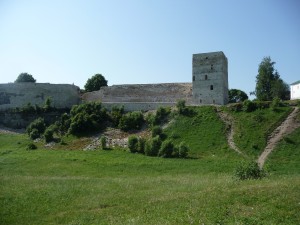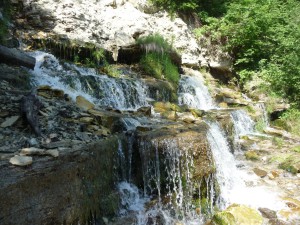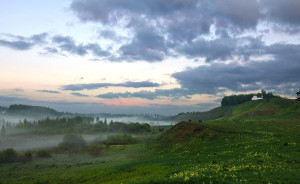Isborsk
 Izborsk is one of the most ancient Russian towns. Izborsk and the most picturesque Izborsk-Maly Valley possess truly priceless historical and cultural legacy.
Izborsk is one of the most ancient Russian towns. Izborsk and the most picturesque Izborsk-Maly Valley possess truly priceless historical and cultural legacy.
The State Architectural and Natural Landscape Museum Preserve Izborsk covers the area of 7,734 hectares, and is a unique combination of historical and archeological monuments, of Old-Russ fortifications, religious and civil buildings, and the scenic natural landscapes.
Izborsk is not merely at the top of the list of ancient Russian towns – it is also a unique natural territory. It is often referred to as a hilly pearl of the Russian plains. The Izborsk hills preserve precious tracts of natural landscape with unique geomorphological and geological terrain aspects, vast diversity of flora and fauna species, unique hydrogeological natural landmarks, as well as landscape and botanic features – both native and atypical of the Northwest. The hydrological monuments include the famous Slovenian Springs – a natural landmark of Izborsk: these powerful outpours of well water in the split of the beach terrace (of Devonian lime slabs) gave Izborsk its 17th-century name of Town on springs. This locale is home to ferns of the Ice Age – though smallish compared to their predecessors. Here, the taiga flora meets the typical flora of  the northwestern plains. The lime stone – as widespread in the Pskov lands as it is – is particularly strong in Izborsk: it is this rock that the Pskov Kremlin walls were built from. Located on the western slope of the Izborsk-Maly Valley by the villages of Konechki and Maly are the unique deposits of tufa – a subsurface rock analogous to lime in its composition, but porous in its structure.
the northwestern plains. The lime stone – as widespread in the Pskov lands as it is – is particularly strong in Izborsk: it is this rock that the Pskov Kremlin walls were built from. Located on the western slope of the Izborsk-Maly Valley by the villages of Konechki and Maly are the unique deposits of tufa – a subsurface rock analogous to lime in its composition, but porous in its structure.
Due to the complex interlacing of archeological, cultural and natural landmarks the Izborsk-MalyValley was declared a complex natural monument. The natural monuments of federal status include: Izborsk-MalyValley, Slovenian Springs, GorodischenskoyeLake, Snake Ravine, Mill Ravine, Through Valley, Dry Bog, Cold Narrow, and the outcrops of cavernous dolomites and tufa.
The protection zone is primarily to account for the geological peculiarities of the Izborsk-MalyValley itself and its vicinities, as it runs along the natural borders defining the hydrological behavior of the valley – forest edge and drainage divides.
The Izborsk fortress is the very ancient town of Izborsk mentioned in the chronicles. The fortress we see today was moved to the Zheravya  (Crane Mount) in 1330 by Pskov posadnik Sheloga, as is evident from the chronicles: “And they set Izborsk on a new spot”.
(Crane Mount) in 1330 by Pskov posadnik Sheloga, as is evident from the chronicles: “And they set Izborsk on a new spot”.
Throughout its history, the fortress was reinforced on multiple occasions by new and stronger fortifications. In lateral view the fortress is an irregular triangle with rounded corners. The assault wall facing west is in the shape of a convex bow. The area within the fortress walls comprises 2.4 hectares, and the total length of the stone walls was up to 850 meters, with the walls being up to 3 meters thick. The towers of the fortress are mainly round, and the gate towers are square. Among those observable today are the oldest Lukovka (onion-shaped), Talava, WatchTower, Mountain-AshTower, PrisonTower, and BellTower.
Located in the fortress near the entrance is St. Nicholas Cathedral — an architectural monument of the early 14th century with a later extension of the belfry. Behind the cathedral, in the eastern wall of the fortress there is the Hider — a steep stair-case vaulted tunnel leading to the underground well the Izborians used as a water source when besieged.
 Today, the fortress is part of the Izborsk Museum Preserve and an exhibit asset. The fortress continuously hosts research and rehabilitation work.
Today, the fortress is part of the Izborsk Museum Preserve and an exhibit asset. The fortress continuously hosts research and rehabilitation work.
Taking into account the vast numbers of sites of historical and cultural legacy in Izborsk and the Maly Valley, as well as the precious tracts of natural landscape with unique geomorphological and geological terrain aspects, vast diversity of flora and fauna species, unique hydrogeological natural landmarks, the area starting January 1996 was declared a State Museum Preserve by the Decree of the RF Government.


